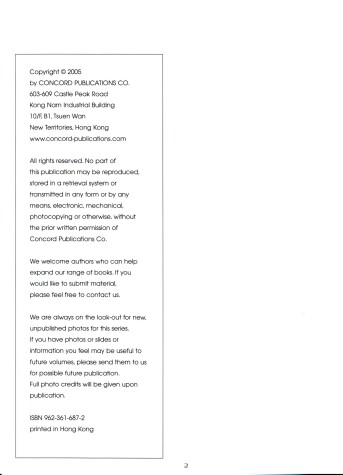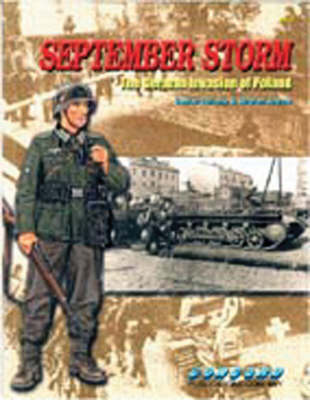Concord - Warrior
3 total works
6506: Soldiers of Destruction: the Ss Death Head Division
by Paul Thomas and Stephen Andrew
Published 1 July 2005
This photographic series examines armed forces from many of the 20th century's greatest conflicts, and gives and insight into the lives of the chief participants. All the photos depict soldiers in the midst of combat, with helpful descriptions of their uniforms, organization and equipment. The 52 page format features...Read more
This photographic series examines armed forces from many of the 20th century's greatest conflicts, and gives and insight into the lives of the chief participants. All the photos depict soldiers in the midst of combat, with helpful descriptions of their uniforms, organization and equipment. The 52 page format features more than 130 photos and up to 4 full clour plates by leading illustrators.
6518: Gebirgsjager - German Mountain Infantry
by Gordon Rottman and Stephen Andrew
Published 1 January 2008
Long before the edelweiss was made famous in "The Sound of Music", this mountain flower was the symbol of Germany's Gebirgstruppen (Mountain Troops)! Especially trained and equipped to operate in alpine regions, these were elite troops of the German army. Incidentally, the common ascription of "Gebirgsjager" actually only refers...Read more
Long before the edelweiss was made famous in "The Sound of Music", this mountain flower was the symbol of Germany's Gebirgstruppen (Mountain Troops)! Especially trained and equipped to operate in alpine regions, these were elite troops of the German army. Incidentally, the common ascription of "Gebirgsjager" actually only refers to "mountain infantrymen". In fact, units were composed of the whole plethora of military occupations such as infantry, artillery, antitank, signals and engineer, for these divisions were self-contained. Gebirgstruppen really had their origin in WWI when fighting against Italian troops in the Alps, and interestingly they still exist today in the Bundeswehr.
This latest volume from Gordon Rottman examines the whole range of Gebirgstruppen in a series of fascinating photos. The book is replete with black and white photos showing these German mountain soldiers in all kinds of environments - sometimes in their natural element on snowy peaks, and at other times at lower altitudes. The photos include details of uniforms, weapons and vehicles used by Gebirgsjager. They also give a representative look at the different geographical regions that these mountain troops operated in. Additionally, each photograph is accompanied by a detailed caption that offers insight into how these soldiers operated and were organized. The usual section of four color plates is the centerpiece of the book, and these high-quality illustrations by Stephen Andrew portray typical details of uniforms and personal equipment.
A number of Gebirgs-Divisions were created as WWII progressed, and all of the divisions are summarized in the introductory text. The same commentary gives a useful explanation of how these divisions were organized. Following in the successful vein of preceding titles in this Concord series, this book is another very helpful work for modelers and military enthusiasts to have on their bookshelves. In"Gebirgsjager - German Mountain Infantry", these soldiers that proudly wore the edelweiss receive the attention they are due.
This latest volume from Gordon Rottman examines the whole range of Gebirgstruppen in a series of fascinating photos. The book is replete with black and white photos showing these German mountain soldiers in all kinds of environments - sometimes in their natural element on snowy peaks, and at other times at lower altitudes. The photos include details of uniforms, weapons and vehicles used by Gebirgsjager. They also give a representative look at the different geographical regions that these mountain troops operated in. Additionally, each photograph is accompanied by a detailed caption that offers insight into how these soldiers operated and were organized. The usual section of four color plates is the centerpiece of the book, and these high-quality illustrations by Stephen Andrew portray typical details of uniforms and personal equipment.
A number of Gebirgs-Divisions were created as WWII progressed, and all of the divisions are summarized in the introductory text. The same commentary gives a useful explanation of how these divisions were organized. Following in the successful vein of preceding titles in this Concord series, this book is another very helpful work for modelers and military enthusiasts to have on their bookshelves. In"Gebirgsjager - German Mountain Infantry", these soldiers that proudly wore the edelweiss receive the attention they are due.
6510 September Storm:the German Invasion of Poland
by Gordon Rottman and Stephen Andrew
Published 1 January 2006
This photographic series examines armed forces from many of the 20th century's greatest conflicts, and gives and insight into the lives of the chief participants. All the photos depict soldiers in the midst of combat, with helpful descriptions of their uniforms, organization and equipment. The 52 page format features...Read more
This photographic series examines armed forces from many of the 20th century's greatest conflicts, and gives and insight into the lives of the chief participants. All the photos depict soldiers in the midst of combat, with helpful descriptions of their uniforms, organization and equipment. The 52 page format features more than 130 photos and up to 4 full clour plates by leading illustrators.
This volume includes:
Photos of German soldiers in the Polish campaign
More than 700, 000 troops, almost 3,300 tanks and 2,100 aircraft took part in the invasion of Poland. This massive force were faced by a well trained, but under-equipped Polish Army that consisted of 500,000 troops with a reserve of 3 million men.
The invasion began on 1 September 1939. The Poles were completely taken by surprise, but put up a strong resistance and caused the Germans delays and some setbacks. Despite this resistance, it took the Germans only a week to reach Warsaw. The city surrendered on 27 September, after heavy aerial bombardment, and the last Polish forces surrendered on 6 October. Described as the'18-day campaign' by German propagandists, the war in fact took over a month. The Germans lost 16,000 soldiers, 32,000 were wounded and over 670 tanks were destroyed.. Over 66,000 Polish soldiers were killed and 134,000 were wounded.
This book was written by Gordon Rottman, a renowned World War II historian, and is backed up by many rare photos of German soldiers in the Polish campaign. The plates were provided by Stephen Andrew, and feature the early war uniform and equipment of the German soldiers.
This volume includes:
Photos of German soldiers in the Polish campaign
More than 700, 000 troops, almost 3,300 tanks and 2,100 aircraft took part in the invasion of Poland. This massive force were faced by a well trained, but under-equipped Polish Army that consisted of 500,000 troops with a reserve of 3 million men.
The invasion began on 1 September 1939. The Poles were completely taken by surprise, but put up a strong resistance and caused the Germans delays and some setbacks. Despite this resistance, it took the Germans only a week to reach Warsaw. The city surrendered on 27 September, after heavy aerial bombardment, and the last Polish forces surrendered on 6 October. Described as the'18-day campaign' by German propagandists, the war in fact took over a month. The Germans lost 16,000 soldiers, 32,000 were wounded and over 670 tanks were destroyed.. Over 66,000 Polish soldiers were killed and 134,000 were wounded.
This book was written by Gordon Rottman, a renowned World War II historian, and is backed up by many rare photos of German soldiers in the Polish campaign. The plates were provided by Stephen Andrew, and feature the early war uniform and equipment of the German soldiers.


